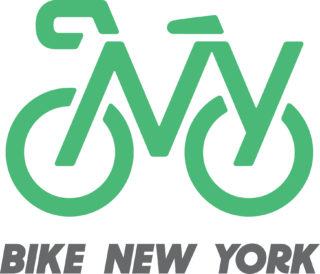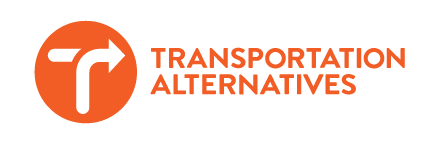June 6, 2019
Congestion pricing is a one-time opportunity for NYC to build a better bike network
This is the joint press release issued on June 6 by Transportation Alternatives and Bike New York, calling on New York City government to take advantage of congestion pricing to create an improved and better connected bike network.
Congestion pricing is projected to significantly reduce motor vehicle volume in Manhattan (London and Stockholm saw reductions of approximately 20% upon implementing congestion pricing). That level of change will allow some street space to be allocated to car alternatives while still improving travel for motor vehicles. Additionally, traffic reduction will not be limited purely to the central business district, but to adjacent areas that serve as corridors for CBD-bound traffic.
For immediate release Thursday June 6 2019
Contact: Joe Cutrufo, Transportation Alternatives 646-873-6027
Jon Orcutt, Bike New York 718-383-6631
Advocates call for long-sought bike network connections and improvements to accompany congestion pricing and traffic reduction
Use the congestion pricing street space dividend to dramatically improve conditions for bike riding
The inclusion of congestion pricing for the Manhattan central business district (CBD) in the NY State budget enacted by Governor Cuomo and the New York State Legislature on April 1 presents an historic opportunity to improve the city’s bike-friendliness and make bicycling accessible to many more New Yorkers, according to Bike New York and Transportation Alternatives.
Congestion pricing is projected to significantly reduce motor vehicle volume in Manhattan (London and Stockholm saw reductions of approximately 20% upon implementing congestion pricing). That level of change will allow some street space to be allocated to car alternatives while still improving travel for motor vehicles. Additionally, traffic reduction will not be limited purely to the central business district, but to adjacent areas that serve as corridors for CBD-bound traffic.
Cycling has increased significantly in New York during the last dozen years, thanks to development of a more thorough and connected bike network, more robust bike lane designs starting in 2007, and the launch and subsequent expansion of Citi Bike, starting in 2013.
Nonetheless, significant gaps in the bike network persist, and protected bike lanes still make up a small share of the overall bike lane system. NYC DOT has been clear that many bike lane gaps have been left because of competition for space in areas with high motor vehicle volume. The reduction in traffic promised by congestion pricing creates an unprecedented opportunity to build a more complete bike network in the city’s core. It’s unclear whether city government is thinking about or working on an initiative along these lines, given Mayor de Blasio’s very late support for congestion pricing.
“For people who don’t want to ride in heavy or fast car traffic, the city’s bike network is only as attractive as its most weakly-designed segment,” said Laura Shepard, communications coordinator at Bike New York. Statistics and surveys on bike use find that women make 20-25% of bike trips in NYC, and that share has remained steady despite significant increases in overall cycling. Surveys and experience elsewhere suggests that closing the gap will require greater separation between the bike network and car traffic, and that requires street space.
London saw a significant jump in cycling – an 83% increase in four years – following implementation of its congestion charge in 2003. It began to allocate street space to bike lanes prior to congestion pricing taking effect.
Second Avenue presents very clear examples of the NYC bike network yielding to heavy motor traffic. The protected bike lane that runs from 125th Street to Houston Street does not continue between 43rd Street to 34th Street approaching the mouth of the Queens Midtown Tunnel. On the West Side, the 8th Avenue protected bike lane similarly lapses alongside the Port Authority bus terminal between 39th and 42nd Streets.
Other major gaps in the Manhattan CBD protected bike lane network include:
- Central Park loop drive to the Queensboro Bridge. 59th Street protected bike lane would be one approach here.
- Central Park loop drive to the Hudson River Greenway. This needs multiple links.
- 6th Avenue from 35th to 59th Streets, and from Houston Street to 8th Street. Filling these gaps has been a long-running Transportation Alternatives campaign, as has 5th Avenue north of 25th Street.
- Church Street between Liberty Street and Franklin Street
- The Lafayette Street/4th Avenue and 8th Avenue protected bike lanes abruptly end at Union Square North and 56th Street, respectively. Protected bike lanes on Central Park West (which Transportation Alternatives has campaigned on for years), and Park Avenue should fill these gaps.
- Extend the Amsterdam Avenue protected bike lane into Midtown/10th Ave, which has also been a priority campaign for Transportation Alternatives’ volunteers for over a decade
- Centre-Lafayette from City Hall to Soho
- Houston Street between 6th Avenue and East River Park
- Greenwich Avenue between Horatio Street and 8th Street
- Bowery and East Broadway between Park Row and the Manhattan Bridge
Traffic reductions resulting from congestion pricing are predicted not only for the central business district itself, but also for CBD-adjacent areas. While the volume of traffic crossing the congestion pricing boundary decreases, traffic patterns will also be rearranged when a uniform East River crossing price puts an end to “toll shopping” – the practice by which drivers change routes to seek free crossings such as the Queensboro Bridge rather than the Triborough Bridge or Midtown Tunnel. Our recommendations in these areas include:
- Extend the protected bike lane network into West and Central Harlem (protected lanes on the West Side now end/begin at 110th Street)
- Protected bike lanes on Northern Boulevard from Grand Central Parkway to Queens Plaza, which has been advocated for by Transportation Alternatives for years.
- Protected bike lane connection between the Pulaski and Queensboro Bridges
- Redesign the Vernon Boulevard protected bike lane so it does not abruptly switch back and forth between sides of the avenue
- Extend Skillman Avenue protected lanes to the area of Pulaski Bridge
- Protected bike lanes on Thomson Ave to calm vehicle traffic exiting the Queensboro Bridge and provide safety for cyclists and pedestrians
- Additional protected routes through or around Downtown Brooklyn; for example, extending protected lanes along Adams Street/Boerum Place south from the Brooklyn Bridge promenade, completing the Jay/Smith Streets protected bike lane to Atlantic Avenue, and connecting bridge entrances and the pending 4th Avenue protected bike lane via a protected route on Ashland Place and Navy Street
- Protected bike lanes along Flatbush Avenue between Empire Boulevard and the Manhattan Bridge
“Other cities have gone to lengths to ensure that alternatives to driving are improved as they prepare to implement congestion pricing,” said Thomas DeVito, Senior Director of Advocacy at Transportation Alternatives. “With ten years of experience building protected bike lanes, New York should be poised to take bike transportation to the next level both in anticipation of, and when congestion pricing and its street space dividend come into effect, in 2021.”
Additional recommendations:
More space for walking to create higher-functioning bike lanes
The 8th Avenue bike lane in the 30s and 40s is unusable during most rush hours because sidewalks cannot hold the volume of pedestrians on the street, and people consequently walk in the bike lane. The city should take advantage of congestion pricing to expand walking space and allow the bike lane to work.
Similarly, reduction in Queensboro Bridge traffic will allow creation of separate cycling and walking paths via conversion of the bridge’s South Outer Roadway, which has been spearheaded by local Transportation Alternatives volunteers since 2016. At present, pedestrians and an increasing volume of two-way bike traffic are confined to a single 12-foot path.
Converting standard unprotected bike lanes to protected lanes
- Manhattan cross-town bike lanes in the 40s
- East Houston Street
- Lafayette Street from SoHo to City Hall (southbound)
- 6th Avenue from 35th-42nd Street (northbound)
- Hudson Street from Canal St to Clarkson St (northbound)
- Avenue C and Madison Street in the East Village/Lower East Side
- Bi-Directional protected bike lanes on Avenue B
- St. Nicholas Avenue north of 116th Street
- The Dyckman Street bike lane should be reinstalled
- In Brooklyn, Bedford Avenue between Atlantic and Flushing, DeKalb Ave, Bergen Street east of Carlton, 3rd Avenue south of Carroll
Short but important links
- Directly link Queensboro Bridge bike path to 2nd Avenue protected bike lane at 60th Street
- Canal Street between Manhattan Bridge and Allen Street bike paths
- Bike and pedestrian friendly Columbus Circle – connections between bike lanes on Broadway, 8th Ave, Central Park West, Central Park loop drive
– 30 –



